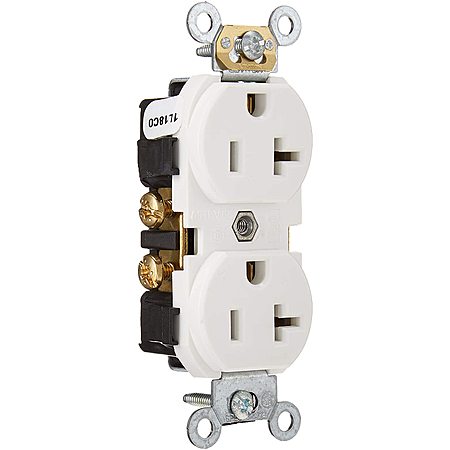expirediconian | Staff posted Feb 22, 2021 09:01 PM
Item 1 of 1
expirediconian | Staff posted Feb 22, 2021 09:01 PM
Leviton CR020-W 20-Amp, 125 Volt, Slim Body Duplex Receptacle (Straight Blade, Commercial Grade, Self Grounding, White) $1.58 @ Amazon
$1.58
Amazon
Visit AmazonGood Deal
Bad Deal
Save
Share



Leave a Comment
25 Comments
Sign up for a Slickdeals account to remove this ad.
If you don't care about electrical inspection, otherwise commercial grade is way better than residential grade ones.
If you don't care about electrical inspection, otherwise commercial grade is way better than residential grade ones.
When something isn't quite all the way plugged in and a small bit of the prongs are still exposed, there's a risk that something might come in contact with the prongs and create a short. Putting the ground on top shields the potentially live prongs. The typical example of this is a paperclip falling behind a desk and hitting the partially exposed prongs on a "normal", ground on the bottom plug, creating a short, and maybe getting stuck in the shorted position. If the plug were ground up, the paperclip would just just hamlessley bounce off.
The other argument is that "normal" plugs kind of look like smiley faces which might be enticing to kids.
edit: BTW, $1.58 is the normal price on these.
Sign up for a Slickdeals account to remove this ad.
Up because if something conductive should fall on a cord partially out, the ground prong will help protect from the live wire prong, or go directly to ground. Since most lamps do not have a ground prong that makes the prior irrelevant, the ground down immediately tells which receptacle is controlled by a switch.
Now, there could be a local electrical code that you will have to inquire for.
When something isn't quite all the way plugged in and a small bit of the prongs are still exposed, there's a risk that something might come in contact with the prongs and create a short. Putting the ground on top shields the potentially live prongs. The typical example of this is a paperclip falling behind a desk and hitting the partially exposed prongs on a "normal", ground on the bottom plug, creating a short, and maybe getting stuck in the shorted position. If the plug were ground up, the paperclip would just just hamlessley bounce off.
The other argument is that "normal" plugs kind of look like smiley faces which might be enticing to kids.
edit: BTW, $1.58 is the normal price on these.
Edit: for home use this is a total overkill and over price. Most home outlets need 15AMP rating receptacles and those can be had on the residential side for around 50c each.
Actual question ! Are these China products?
https://www.leviton.com/en/products/t5820-w
Oh well! Too good to be true.
Sign up for a Slickdeals account to remove this ad.
Leave a Comment